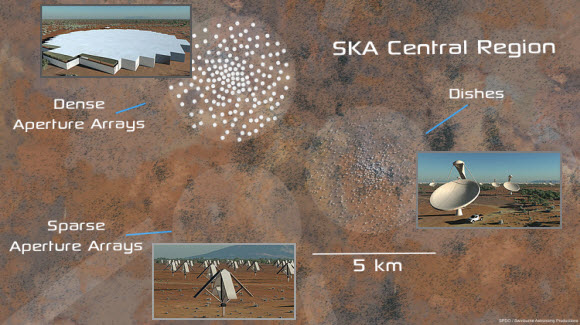
Dr Melvin Hoare
(Leeds University)
The Square Kilometre Array (SKA) project is an international effort to build the world’s largest radio telescope, with eventually over a square kilometre (one million square metres) of collecting area. The scale of the SKA represents a huge leap forward in research and development towards building and delivering a unique instrument and preparations are now well under way.
The original Motivation was to create a map of atomic hydrogen at a specific wavelength of 21 cm at 1 arcsecond resolution out to a redshift of 2 (the minimum area required to achieve this mapping was 1sqkm.) Using existing radio telescopes, currently emission maps have a resolution of only 10 arc seconds achievable out to a distance of redshift - 0.2 The SKA will eventually employ up to 2000 x 15 metre dishes that will enable astronomers to monitor the sky in unprecedented detail. In addition LOFAR will employ a network of over 100 thousand dipole non moveable aerials to study low frequencies, the signals being ‘digitally moved’.
Two sites have been chosen to co-host the radio dishes and antennae, chiefly because of access, remoteness (radio quiet) and atmospheric conditions above the sites. South Africa’s Karoo desert will host the core of the high and mid frequency dishes, ultimately extending over the African continent. Australia’s Murchison Shire will host the low frequency antennas.

Schematic of SKA Central Region with artists impressions of Dense Aperture Array Station, Low-Band Sparse Aperture Array Station and Offset Gregorian Antennas (dishes).
Ten member countries are the cornerstone of the SKA, but many more are participating in some way. Scientists and engineers are designing and developing a system which uses ultra fast supercomputers, and network technology that will generate more data traffic than the entire Internet.
Due to funding constraints the SKA will be developed over a phased timeline. Pre-construction development started in 2012 and will last until the latter half of this decade. The main bulk of the SKA will be built in two main phases. Phase 1 is already completely funded and will be used in testing the full system in a “proof of concept” manner. Australia will host the low-frequency instrument with more than 500 stations, each containing around 250 individual antennas, whilst South Africa will host an array of some 200 dishes, incorporating the 64-dish MeerKAT precursor telescope due for completion by 2023.
Phase 2 is not fully funded as yet, but will complete the telescope arrays at both sites, and become fully operational by around 2030 (it is hoped) by which time the SKA will count with some 2000 high and mid frequency dishes and aperture arrays and a million low frequency antennas.
Melvin has already been out to Africa to commence training students, 10 or so a year, some of our overseas budget being used for scientific purposes. The SKA will start conducting science observations in 2020 with a partial array.
The headquarters of SKA will be based at Jodrell Bank and it is hoped that eventually redundant dishes in the UK at Goon hilly will be converted and linked into the MERLIN radio dish system, becoming an extension of SKA.
Once completed, the SKA will be able to conduct transformational science, breaking new ground in astronomical observations. These include challenging Einstein’s theory of relativity to the limits, looking at how the very first stars and galaxies formed just after the big bang, in a way never before observed in any detail, helping scientists understand the nature of a mysterious force known as dark energy. They will also study pulsars in proximity of black holes. It will look for signs of planetary formation and ‘micro building block processes’ as well as molecular signatures in the outer regions of proto planetary disks. Exo planet characterizations, low frequency radio emissions from the rotation of planetary/moon magnetics will also be on the agenda. Finally SKA will be used for one of the greatest mysteries known to humankind…are we alone in the Universe, by looking at SETI targets. The SKA will truly be at the forefront of scientific research.
- Log in to post comments

